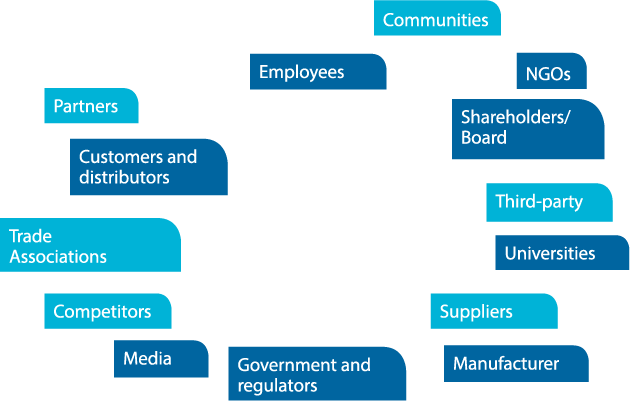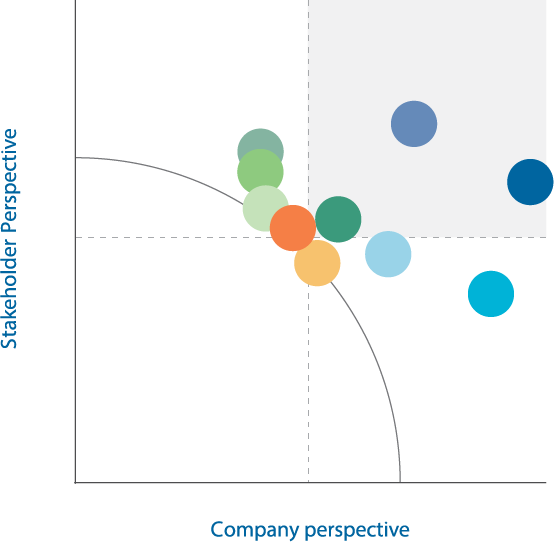About this report
G4-18We have used a systematic approach to identifying issues that are relevant to our sustainability management for the first time in developing this report. This set of relevant issues has been identified using the materiality principle to develop content that is relevant to and meets the expectations of our stakeholders. A materiality exercise is part of the reporting framework established by the Global Reporting Initiative (GRI), a recognized authority in sustainability reporting. This report is in accordance with the Core option of the G4 GRI guidelines, which a focus on identified material issues. G4-32
Nitro Quimica began monitoring and reporting on our sustainability indicators using this methodology from 2016. In addition to providing a snapshot of each aspect based on monitored disclosures, we can also establish goals for each metric and translate them into actions to improve our sustainability management. The data presented in this report is for our Brazilian operations. Over the coming years we will additionally report on our US-based acquisition, Alchemix. G4-17
The decision to publish our Annual and Sustainability Report is part of an effort to further our communications and dialog with stakeholders.
The materiality process was initiated in 2016 with the identification and definition of our internal and external stakeholders. Issues that are material to the company and our industry were then identified from a collection of Company, industry and sustainability documentation.
After identifying 22 key issues, a stakeholder survey was conducted using on-line forms and in person and telephone interviews. Employees, suppliers, distributors and customers as well as community members and an industry association were invited to participate in this preliminary process. Interviews were also held with the CEO and company executives. Ten issues were deemed most relevant in the stakeholder survey and were validated by top management as material issues. G4-24, G4-26
Stakeholder map
G4-25A workshop with key management personnel identified and prioritized Nitro Quimica’s stakeholder groups

Materiality matrix
G4-19, G4-27Nitro Quimica has developed a materiality matrix out of identified material issues, containing five strategic pillars spanning 10 material issues:


Disclosures by material topic
G4-20, G4-21Nitro Quimica has developed a materiality matrix out of identified material issues
| MATERIAL ISSUE | GRI ASPECTS AND DISCLOSURES | WHERE THEY OCCUR (affected stakeholders) |
|---|---|---|
| Product and process innovation (research and development of safer chemicals, solvents and auxiliary substances) | Economic performance G4-EC1: statement of added value (EVG&D)* | Within and outside the organization (employees; universities, customers and partners) |
| Process and operations safety (incident, spill and fire prevention at our plants and distributors and during product transportation) | Customer health and safety G4-PR1: Percentage of product categories for which health and safety impacts are assessed for improvement G4-PR2: Total number of incidents of non-compliance concerning the health and safety impacts of products during their life cycle Effluents and waste G4-EN24: Total number and volume of significant spills | Within and outside the organization (employees and third-party workers; community and suppliers) |
| Employee health and safety (exposure to chemicals, handling hazardous and flammable products; medical management) | Health & safety G4-LA6: Rates of injury, occupational diseases, and absenteeism G4-LA7: Rates of occupational disease G4-LA16: Number of grievances about labor practices | Within and outside the organization (employees and third-party workers; community) |
| Community health and safety risks (liability in the event of a toxic release, loss of operational control or fire; community engagement) | Local communities G4-SO2: Operations with significant actual or potential negative impacts on local communities | Within and outside the organization (employees and third-party workers; community) |
| Stakeholder engagement (including transparent communication and grievance management) | Grievance and complaints mechanisms related to impacts on society G4-SO11: Number of grievances about environmental impacts | Outside the organization (industry associations, community, government and press) |
| Local development (community relations and programs) | Significant indirect economic impacts, including the extent of impacts G4-EC8: Significant indirect economic impacts Procurement practices G4-EC9: Proportion of spending on locally-based suppliers at significant locations of operation | Outside the organization (community, suppliers and government) |
| Emissions control (releases of gases and volatile organic compounds [VOC] and carbon capture) | Emissions G4-EN15: Indirect greenhouse gas (GHG) emissions (Scope 1) G4-EN16: Energy indirect greenhouse gas (GHG) emissions (Scope 2) G4-EN17: Other indirect greenhouse gas (GHG) emissions (Scope 3) G4-EN20: Emissions of ozone-depleting substances (ODS) G4-EN21: NOx, SOx, and other significant air emissions | Within and outside the organization (employees; community and government) |
| Water management (water usage efficiency and reuse) | Water G4-EN8: Total water withdrawal by source G4-EN10: Percentage and total volume of water recycled and reused Effluents and waste G4-EN22: Total water discharge by quality and destination | Within and outside the organization (employees; community, customers and government) |
| Waste management (waste recycling, treatment and proper disposal) | Effluents and waste G4-EN23: Total weight of waste by type and disposal method G4-EN25: Weight of transported, imported, exported, or treated waste deemed hazardous under the terms of the Basel Convention | Within and outside the organization (employees; community and government) |
| Development of human capital (training and education) | Employment G4-LA1: Rates of new employee hires and employee turnover G4-LA2: Benefits provided to full-time and temporary employees Training and education G4-LA9: Average hours of training G4-LA11: Percentage of employees that regularly undergo performance and career development analyses Market presence G4-EC5: Variance between the lowest wage compared to the local minimum wage | Within the organization (employees) |
**This disclosure was not addressed in this initial reporting cycle and has been included as an opportunity for improvement in the following years.
Any suggestions or questions about the topics addressed in this report can be submitted by e-mail to [email protected]
